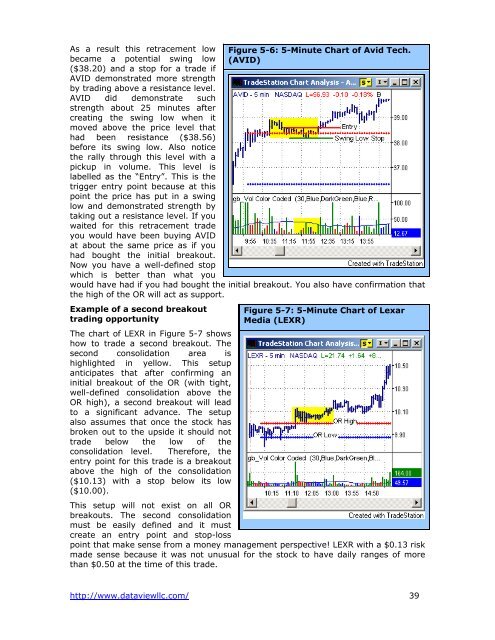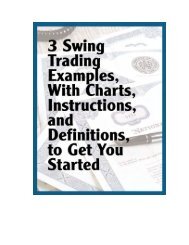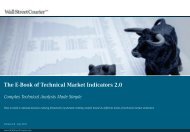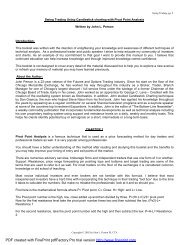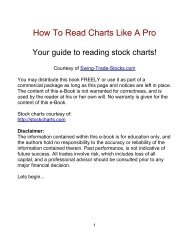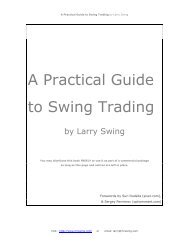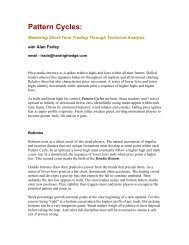Trading the Opening Range - The Swing Trading Guide
Trading the Opening Range - The Swing Trading Guide
Trading the Opening Range - The Swing Trading Guide
Create successful ePaper yourself
Turn your PDF publications into a flip-book with our unique Google optimized e-Paper software.
As a result this retracement low<br />
became a potential swing low<br />
($38.20) and a stop for a trade if<br />
AVID demonstrated more strength<br />
by trading above a resistance level.<br />
AVID did demonstrate such<br />
strength about 25 minutes after<br />
creating <strong>the</strong> swing low when it<br />
moved above <strong>the</strong> price level that<br />
had been resistance ($38.56)<br />
before its swing low. Also notice<br />
<strong>the</strong> rally through this level with a<br />
pickup in volume. This level is<br />
labelled as <strong>the</strong> “Entry”. This is <strong>the</strong><br />
trigger entry point because at this<br />
point <strong>the</strong> price has put in a swing<br />
low and demonstrated strength by<br />
taking out a resistance level. If you<br />
waited for this retracement trade<br />
you would have been buying AVID<br />
at about <strong>the</strong> same price as if you<br />
had bought <strong>the</strong> initial breakout.<br />
Now you have a well-defined stop<br />
which is better than what you<br />
would have had if you had bought <strong>the</strong> initial breakout. You also have confirmation that<br />
<strong>the</strong> high of <strong>the</strong> OR will act as support.<br />
Example of a second breakout<br />
trading opportunity<br />
<strong>The</strong> chart of LEXR in Figure 5-7 shows<br />
how to trade a second breakout. <strong>The</strong><br />
second consolidation area is<br />
highlighted in yellow. This setup<br />
anticipates that after confirming an<br />
initial breakout of <strong>the</strong> OR (with tight,<br />
well-defined consolidation above <strong>the</strong><br />
OR high), a second breakout will lead<br />
to a significant advance. <strong>The</strong> setup<br />
also assumes that once <strong>the</strong> stock has<br />
broken out to <strong>the</strong> upside it should not<br />
trade below <strong>the</strong> low of <strong>the</strong><br />
consolidation level. <strong>The</strong>refore, <strong>the</strong><br />
entry point for this trade is a breakout<br />
above <strong>the</strong> high of <strong>the</strong> consolidation<br />
($10.13) with a stop below its low<br />
($10.00).<br />
Figure 5-6: 5-Minute Chart of Avid Tech.<br />
(AVID)<br />
Figure 5-7: 5-Minute Chart of Lexar<br />
Media (LEXR)<br />
This setup will not exist on all OR<br />
breakouts. <strong>The</strong> second consolidation<br />
must be easily defined and it must<br />
create an entry point and stop-loss<br />
point that make sense from a money management perspective! LEXR with a $0.13 risk<br />
made sense because it was not unusual for <strong>the</strong> stock to have daily ranges of more<br />
than $0.50 at <strong>the</strong> time of this trade.<br />
http://www.dataviewllc.com/ 39


